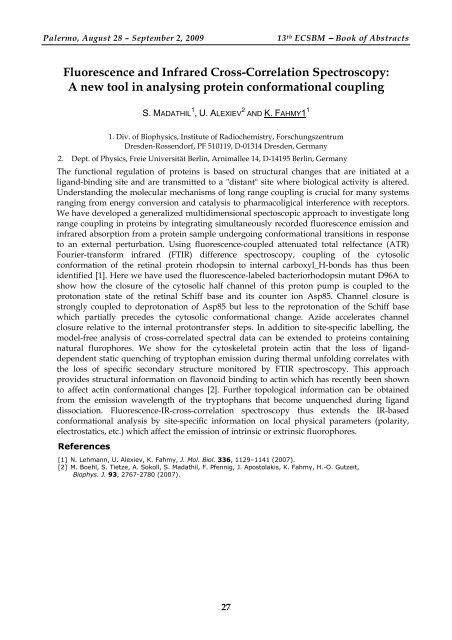XIII European Conference on the Spectroscopy of ... - ecsbm 2009
XIII European Conference on the Spectroscopy of ... - ecsbm 2009
XIII European Conference on the Spectroscopy of ... - ecsbm 2009
You also want an ePaper? Increase the reach of your titles
YUMPU automatically turns print PDFs into web optimized ePapers that Google loves.
Palermo, August 28 – September 2, <strong>2009</strong> 13 th ECSBM −−−− Book <strong>of</strong> Abstracts<br />
Fluorescence and Infrared Cross-Correlati<strong>on</strong> <strong>Spectroscopy</strong>:<br />
A new tool in analysing protein c<strong>on</strong>formati<strong>on</strong>al coupling<br />
S. MADATHIL 1 , U. ALEXIEV 2 AND K. FAHMY1 1<br />
1. Div. <strong>of</strong> Biophysics, Institute <strong>of</strong> Radiochemistry, Forschungszentrum<br />
Dresden-Rossendorf, PF 510119, D-01314 Dresden, Germany<br />
2. Dept. <strong>of</strong> Physics, Freie Universität Berlin, Arnimallee 14, D-14195 Berlin, Germany<br />
The functi<strong>on</strong>al regulati<strong>on</strong> <strong>of</strong> proteins is based <strong>on</strong> structural changes that are initiated at a<br />
ligand-binding site and are transmitted to a "distant" site where biological activity is altered.<br />
Understanding <strong>the</strong> molecular mechanisms <strong>of</strong> l<strong>on</strong>g range coupling is crucial for many systems<br />
ranging from energy c<strong>on</strong>versi<strong>on</strong> and catalysis to pharmacoligical interference with receptors.<br />
We have developed a generalized multidimensi<strong>on</strong>al spectoscopic approach to investigate l<strong>on</strong>g<br />
range coupling in proteins by integrating simultaneously recorded fluorescence emissi<strong>on</strong> and<br />
infrared absorpti<strong>on</strong> from a protein sample undergoing c<strong>on</strong>formati<strong>on</strong>al transiti<strong>on</strong>s in resp<strong>on</strong>se<br />
to an external perturbati<strong>on</strong>. Using fluorescence-coupled attenuated total relfectance (ATR)<br />
Fourier-transform infrared (FTIR) difference spectroscopy, coupling <strong>of</strong> <strong>the</strong> cytosolic<br />
c<strong>on</strong>formati<strong>on</strong> <strong>of</strong> <strong>the</strong> retinal protein rhodopsin to internal carboxyl_H-b<strong>on</strong>ds has thus been<br />
identified [1]. Here we have used <strong>the</strong> fluorescence-labeled bacteriorhodopsin mutant D96A to<br />
show how <strong>the</strong> closure <strong>of</strong> <strong>the</strong> cytosolic half channel <strong>of</strong> this prot<strong>on</strong> pump is coupled to <strong>the</strong><br />
prot<strong>on</strong>ati<strong>on</strong> state <strong>of</strong> <strong>the</strong> retinal Schiff base and its counter i<strong>on</strong> Asp85. Channel closure is<br />
str<strong>on</strong>gly coupled to deprot<strong>on</strong>ati<strong>on</strong> <strong>of</strong> Asp85 but less to <strong>the</strong> reprot<strong>on</strong>ati<strong>on</strong> <strong>of</strong> <strong>the</strong> Schiff base<br />
which partially precedes <strong>the</strong> cytosolic c<strong>on</strong>formati<strong>on</strong>al change. Azide accelerates channel<br />
closure relative to <strong>the</strong> internal prot<strong>on</strong>transfer steps. In additi<strong>on</strong> to site-specific labelling, <strong>the</strong><br />
model-free analysis <strong>of</strong> cross-correlated spectral data can be extended to proteins c<strong>on</strong>taining<br />
natural flurophores. We show for <strong>the</strong> cytoskeletal protein actin that <strong>the</strong> loss <strong>of</strong> liganddependent<br />
static quenching <strong>of</strong> tryptophan emissi<strong>on</strong> during <strong>the</strong>rmal unfolding correlates with<br />
<strong>the</strong> loss <strong>of</strong> specific sec<strong>on</strong>dary structure m<strong>on</strong>itored by FTIR spectroscopy. This approach<br />
provides structural informati<strong>on</strong> <strong>on</strong> flav<strong>on</strong>oid binding to actin which has recently been shown<br />
to affect actin c<strong>on</strong>formati<strong>on</strong>al changes [2]. Fur<strong>the</strong>r topological informati<strong>on</strong> can be obtained<br />
from <strong>the</strong> emissi<strong>on</strong> wavelength <strong>of</strong> <strong>the</strong> tryptophans that become unquenched during ligand<br />
dissociati<strong>on</strong>. Fluorescence-IR-cross-correlati<strong>on</strong> spectroscopy thus extends <strong>the</strong> IR-based<br />
c<strong>on</strong>formati<strong>on</strong>al analysis by site-specific informati<strong>on</strong> <strong>on</strong> local physical parameters (polarity,<br />
electrostatics, etc.) which affect <strong>the</strong> emissi<strong>on</strong> <strong>of</strong> intrinsic or extrinsic fluorophores.<br />
References<br />
[1] N. Lehmann, U. Alexiev, K. Fahmy, J. Mol. Biol. 336, 1129–1141 (2007).<br />
[2] M. Boehl, S. Tietze, A. Sokoll, S. Madathil, F. Pfennig, J. Apostolakis, K. Fahmy, H.-O. Gutzeit,<br />
Biophys. J. 93, 2767-2780 (2007).<br />
27


